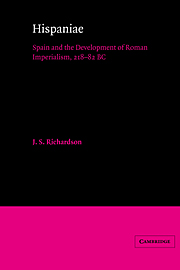Book contents
- Frontmatter
- Contents
- List of maps
- Preface
- Abbreviations
- 1 Spain and Roman imperialism
- 2 Spain before the Romans
- 3 The war zone: 218–206
- 4 Continuity and adaptation: 206–194
- 5 The shaping of the provinciae: 193–155
- 6 The consular provinciae: the wars in Spain 155–133
- 7 From provinciae to provinces: 133–82
- 8 Rome, Spain and imperialism
- Appendices
- Bibliography
- Index
7 - From provinciae to provinces: 133–82
Published online by Cambridge University Press: 07 September 2009
- Frontmatter
- Contents
- List of maps
- Preface
- Abbreviations
- 1 Spain and Roman imperialism
- 2 Spain before the Romans
- 3 The war zone: 218–206
- 4 Continuity and adaptation: 206–194
- 5 The shaping of the provinciae: 193–155
- 6 The consular provinciae: the wars in Spain 155–133
- 7 From provinciae to provinces: 133–82
- 8 Rome, Spain and imperialism
- Appendices
- Bibliography
- Index
Summary
The half-century which separated the tribunate of Ti. Gracchus in 133 from Sulla's return to Rome in 82 was of immense significance for the history of the Roman republic. In Spain the same period, beginning with Scipio Aemilianus' capture of Numantia and ending with the first phase of the Sertorian wars, has left almost no trace in the extant historical sources. Appian, whose account of Scipio's campaign alone covers eight pages of the Teubner text, deals with the next 50 years in just one page. The disasters of the wars against Numantia and Viriathus, and the eventual defeat of both those enemies, had a glamour which was evidently lacking from the events which followed.
As a result of this silence, it is difficult to make any evaluation of the activity of the men sent to command in Spain, or of the policy of the senate which assigned them to the two provinciae. It is possible, however, by comparing such little information as survives with the clearer patterns of the earlier part of the second century, to trace elements both of continuity and of development in Roman attitudes to Spain, it is important that the attempt be made, because the end of this period marked an important stage in the gradual emergence of the idea of the province as part of a Roman empire.
- Type
- Chapter
- Information
- HispaniaeSpain and the Development of Roman Imperialism, 218–82 BC, pp. 156 - 171Publisher: Cambridge University PressPrint publication year: 1986

